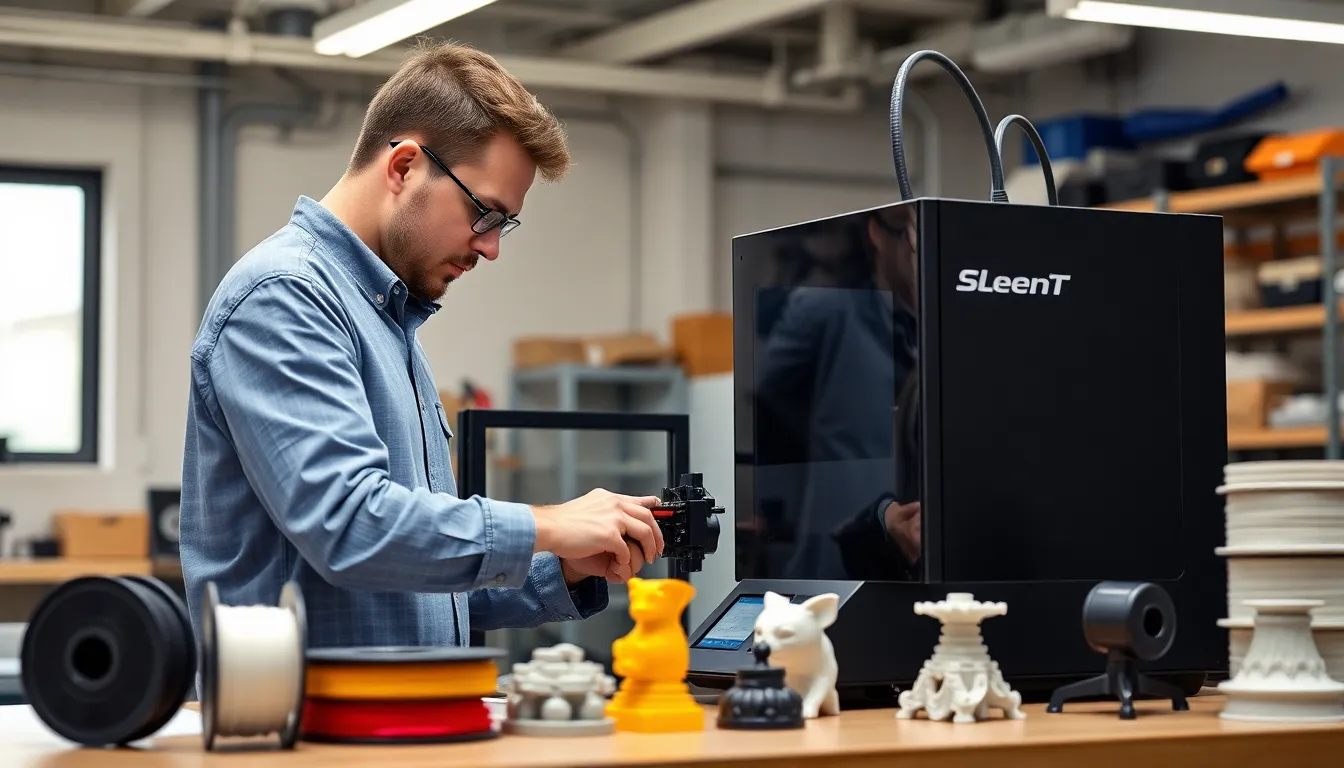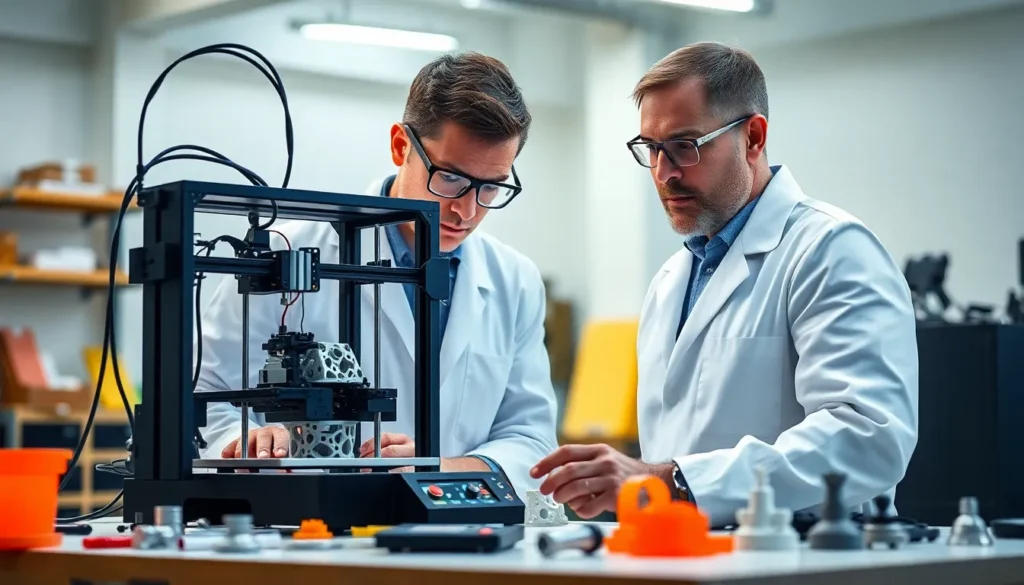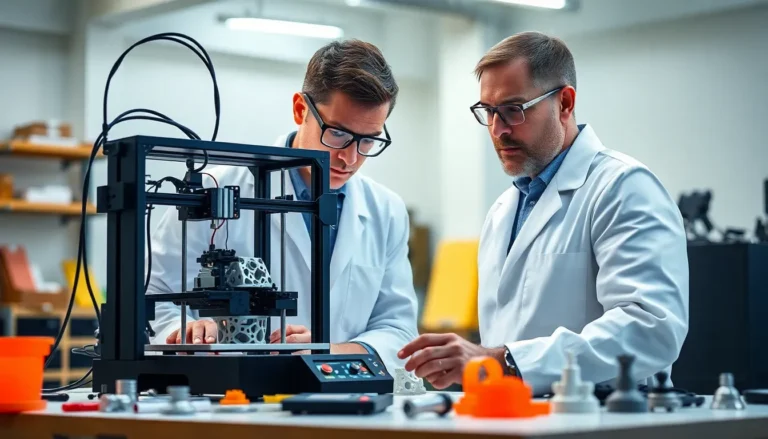In a world where ideas can materialize faster than you can say “3D print me a coffee,” professional 3D printing solutions are revolutionizing industries. Gone are the days of waiting for prototypes to arrive by snail mail. Now, businesses can whip up designs in a matter of hours, leaving competitors wondering if they’ve stepped into a sci-fi movie.
Table of Contents
ToggleOverview of Professional 3D Printing Solutions
Professional 3D printing solutions offer significant advantages across various sectors. Industries such as aerospace, automotive, and healthcare benefit from improved prototyping efficiency and product development. The technology enables rapid iteration, transforming concepts into tangible prototypes within hours.
Additive manufacturing, a core element of professional 3D printing, allows for intricate designs that traditional methods struggle to achieve. Companies can create lightweight components that enhance performance and reduce material waste. Furthermore, the ability to customize parts meets the specific needs of clients, leading to enhanced satisfaction and competitiveness.
Materials used in professional 3D printing include plastics, metals, and ceramics. Each material presents unique properties suitable for different applications. For instance, thermoplastics are often chosen for their strength and durability, while metals provide enhanced structural integrity needed in aerospace components.
Advanced software tools facilitate the design and modeling process, streamlining workflows. Engineers can manipulate designs virtually before committing to printing. This capability reduces errors, saving time and costs associated with iterations and revisions.
Support for professional 3D printing solutions includes comprehensive service from technology providers. Companies receive guidance on machine selection, materials, and post-processing techniques. With ongoing support, businesses can optimize their 3D printing operations to achieve maximum efficiency.
Emerging trends such as bioprinting and large-scale printing further illustrate the potential of professional 3D printing solutions. These innovations will likely reshape product development and manufacturing processes, positioning companies at the forefront of their respective industries.
Key Technologies in Professional 3D Printing


Professional 3D printing employs various technologies, each catering to specific applications and material requirements.
Fused Deposition Modeling (FDM)
Fused Deposition Modeling remains one of the most popular methods in professional 3D printing. This technique uses thermoplastic filament, extruding it through a heated nozzle to build layers. FDM’s accessibility and cost-effectiveness appeal to a wide range of industries, including aerospace and consumer goods. Engineers favor FDM for its ability to create strong prototypes quickly. Various materials, such as ABS and PLA, suit different mechanical properties and applications. Users appreciate FDM for straightforward operation and compatibility with desktop printers.
Stereolithography (SLA)
Stereolithography stands out for its precision and detail. This method employs a UV laser to solidify liquid resin layer by layer. SLA technology excels in producing high-resolution parts, making it ideal for applications requiring intricate designs, like dental or jewelry models. A smooth surface finish differentiates SLA from other technologies. This process supports a variety of photopolymer resin materials, enabling diverse characteristics from flexibility to rigidity. Professionals rely on SLA for rapid prototyping, particularly in specialized industries.
Selective Laser Sintering (SLS)
Selective Laser Sintering utilizes a laser to fuse powdered materials into solid structures. This technique often employs nylon, making it suitable for producing durable parts with complex geometries. SLS requires no support structures, allowing for greater design freedom. As the laser scans, it effectively binds each layer together, enabling strong and functional prototypes. Applications in aerospace, automotive, and manufacturing benefit from SLS technology’s ability to create lightweight yet resilient components. This method remains a preferred choice for businesses aiming to improve product performance while minimizing material waste.
Applications of Professional 3D Printing
Professional 3D printing technology serves various industries, transforming how products are developed and manufactured. The applications range from industrial prototyping to aerospace components.
Industrial Prototyping
Industrial prototyping benefits significantly from professional 3D printing solutions. Rapid prototyping allows companies to create high-quality models quickly, enabling faster decision-making. Iterative design processes become more efficient as teams test and refine concepts in real-time. Furthermore, businesses reduce costs associated with traditional prototyping methods, which often involve lengthy lead times and material wastage. The use of 3D printing not only accelerates the development timeline but also enhances collaboration among engineers, designers, and stakeholders.
Medical Devices
In the medical sector, 3D printing revolutionizes the design and production of medical devices. Custom implants and prosthetics tailored to individual patients improve fit and functionality. Surgeons also benefit from 3D-printed anatomical models, which help in pre-surgical planning. High-quality materials ensure that devices meet stringent safety standards while enabling intricate details that traditional manufacturing cannot achieve. Manufacturers in this field capitalize on the flexibility of 3D printing to innovate and bring new solutions to market swiftly.
Aerospace Components
Aerospace components leverage the advantages of professional 3D printing for lightweight and durable parts. This technology enables the production of complex geometries that enhance performance while minimizing material waste. Aerospace manufacturers rely on advanced 3D printing processes to reduce the weight of components, contributing to fuel efficiency and overall cost savings. Additionally, rapid iteration facilitates quicker testing and deployment of new designs, responding to market demands more effectively. The integration of 3D printing in aerospace reshapes the landscape, positioning companies as leaders in innovation.
Benefits of Using Professional 3D Printing Solutions
Professional 3D printing solutions offer substantial advantages across industries, enhancing processes and outcomes significantly.
Cost-Effectiveness
Reduced material waste enhances cost efficiency in manufacturing. Utilizing advanced technologies, companies can minimize expenses related to prototypes by producing only what they need. Moreover, quick production times lower operational costs by decreasing labor hours. Access to diverse materials ensures businesses choose the most cost-effective option without sacrificing quality. Companies benefit from lower shipping costs since local production eliminates long-distance transportation. Additionally, 3D printing encourages efficient resource usage, effectively optimizing financial investments.
Customization Capabilities
Endless design possibilities allow businesses to tailor products to specific customer needs. Unique designs can be created with minimal additional costs, presenting opportunities for niche markets. Each customization reflects precise requirements, ensuring enhanced functionality and satisfaction. Whether intricate medical devices or tailored consumer products, the technology adapts rapidly to different demands. Companies gain a competitive edge when they deliver one-of-a-kind solutions that distinguish them in crowded markets. Diversified applications further support personalized experiences for users.
Speed and Efficiency
Rapid prototyping accelerates the product development lifecycle significantly. Designs transition from concepts to physical models within hours, enabling quick iterations. Engineers can test and refine prototypes much faster than traditional methods allow. This swift turnaround results in shortened time-to-market timelines, giving businesses a lead over competitors. Furthermore, additive manufacturing supports on-demand production, which simplifies inventory management. Efficient processes translate into enhanced responsiveness to market changes, fostering innovation-focused environments.
Challenges and Considerations
Professional 3D printing solutions present challenges that require careful consideration to optimize their use effectively.
Material Limitations
Materials in professional 3D printing vary widely, each with unique properties. Plastics, while versatile, may not always provide the strength needed for specific applications. Metals offer durability but often come with higher costs and specialized printing requirements. Ceramics present another option but can be brittle and challenging to manipulate. Understanding these limitations plays a critical role in selecting the right material for the desired application. Manufacturers often face restrictions that can influence design possibilities. Companies benefit from thorough material research to ensure compatibility with intended uses.
Technology Adoption
Implementing professional 3D printing technology can pose significant challenges for businesses. Employee training and skill development often require investment and time. Integrating new systems into existing workflows may disrupt operational efficiency. Companies also encounter varied levels of familiarity with 3D printing across teams. To overcome these barriers, organizations can leverage partnerships with technology providers. Collaborating with experts can streamline the adoption process and ease the transition. Access to training programs also supports skill enhancement. Prioritizing a structured approach will maximize the benefits of professional 3D printing solutions.
Professional 3D printing solutions are revolutionizing industries by enhancing efficiency and innovation. With the ability to produce complex designs rapidly and cost-effectively, businesses are better positioned to meet market demands and customize products for their customers.
As technology continues to evolve, the potential applications and benefits of 3D printing will only expand. Companies that embrace these advancements will likely gain a significant competitive edge.
Navigating the challenges associated with this technology is essential for maximizing its advantages. By collaborating with experienced providers and investing in training, businesses can harness the full potential of professional 3D printing, leading to improved product development and manufacturing processes.



